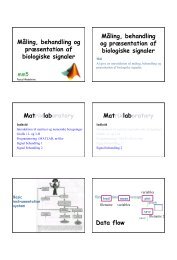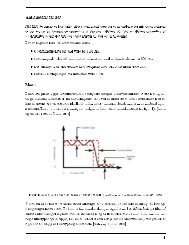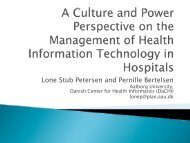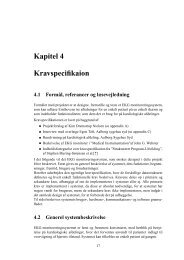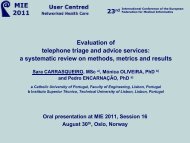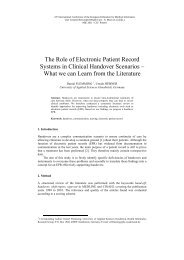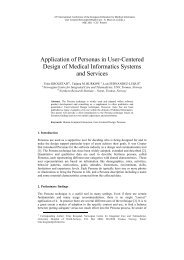Lecture note
Lecture note
Lecture note
You also want an ePaper? Increase the reach of your titles
YUMPU automatically turns print PDFs into web optimized ePapers that Google loves.
Systems Pass away - Data Consists (hopefully)<br />
24. november 2011<br />
04:30<br />
Hospital A has decided to buy and implement an EHR. You are part of the group that has to give<br />
advice to the board of the hospital. The board wants your input on how to build/develop/grow an<br />
information system at the hospital that will make Hospital A ”the role model” in the region/of the<br />
nation. Remember arguments and references.<br />
Here you have my <strong>note</strong>s on inputs to Hospital A . The <strong>note</strong>s are not well organised or checked for spelling or<br />
grammar, but hopefully you will get the idea anyhow.<br />
Before you take such an assignment to you, it is important that you understand what the Board sees as being<br />
a role model. What do you think they see as success criterias? Good user experiences? Rapid deployment?<br />
Cheap solution? - Probally not!<br />
Often it is the Boardmembers reputation that is the driving force when they are to pick a new strategy or<br />
EHR solution. Your recomendations are to ensure them that the risk of failure is minimal and chance of being<br />
the role model is optimal.<br />
Will you recomend the Board to pick an EHR from the biggest vendor in the country?<br />
This is what Boards have chosen so fare. What will the outcome look like?<br />
- Low risk ??<br />
- No role model<br />
- High cost!!!<br />
As discussed earlier in this course - it is very difficult to give a clear answer as to what an EHR is.Therefore<br />
my claim is that hospital (A) already have an EHR. It's just a question of ensuring a simple approach to the<br />
systems they already have.<br />
What are the advantages of such an approach? It is not yet a new big bang solution, with all the<br />
uncertainties thus follows.<br />
How can such an approach be possible? Can you get anything useful out of all the information gathered in<br />
many different databases with no interoperability?<br />
Yes. If one divides systems from data. And perhaps acquire new standalone dedicated systems, which<br />
supports workflow the best way.<br />
AAU side 1
Taking the dataperspective on what is being done.<br />
Before any EPR<br />
Economy<br />
HR<br />
Different records<br />
Different records<br />
Different records<br />
Booking<br />
Clinical Clinical registry registry<br />
Clinical registry<br />
PAS<br />
PAS<br />
DRG<br />
Phatology<br />
Todays picture where they have chosen an EPR implementation<br />
Clinical registry AAU side 2<br />
Small Small devices devices EKG ECG etc. etc.<br />
Small devices ECG etc .<br />
Radiology<br />
Laboratory<br />
Laboratory<br />
Laboratory<br />
Blood
Economy<br />
HR<br />
Different records<br />
Different records<br />
Phatology<br />
Clinical registry<br />
Clinical registry<br />
Clinical registry<br />
Clinical registry<br />
EPR<br />
DRG<br />
Small devices ECG etc .<br />
Laboratory<br />
Historic records<br />
and patient<br />
administrations<br />
What has happened in the transaction to the EPRs we have today is granularity loss and history archiving.<br />
Due to the cost of system interoperability and the ever changing standardization (in my opinion) and due to<br />
the fact that it is a hard task to build an complete ERP-system from the ground.<br />
"I have a little story about this. Last week I had a meeting with a guy named Steen Friberg. Former Clinical<br />
Director at Horsens Hospital. He now sits as Chairman of a small company in Aarhus, called<br />
Cetrea. Cetrea and SYSTEMATIC, has lately been on a road trip together with the royal Prince to the US.<br />
SYSTEMATIC can present an attractive EHR system with interoperalitet and a nice UI. Cetrea has a system<br />
that supports the work flow around the inpatients, but their system has no interoperability to other systems.<br />
Cetrea ended up with contracts to US hospitals SYSTEMATIC didn't! You cannot make any conclusions based<br />
on such stories, but Cetreas system is based upon a "thorough understanding of the practices in which the<br />
system are to function" - Berg 1999. SYSTEMATIC has build their system according to requirements written by<br />
people who have read many of the same articles you now are studying."<br />
Will Hospital (A) choose this path?<br />
Of course not.<br />
This would be the wonderful setup<br />
AAU side 3
This would be the wonderful setup<br />
Economy<br />
HR<br />
Different records<br />
Different records<br />
Different records<br />
Booking<br />
All transaction systems<br />
subscribe to central hub for<br />
keys and shared attrbutes .<br />
Master data service is the<br />
system of record for all<br />
descriptive information. No<br />
downstream integration is<br />
needed, because data is<br />
integrated as it is created<br />
Clinical Clinical registry registry<br />
Clinical registry<br />
PAS<br />
PAS<br />
Phatology<br />
Master data Service Hub<br />
Including Clinical<br />
Terminology amongst<br />
other master data<br />
DW ETL<br />
DRG<br />
Small Small devices devices EKG ECG etc. etc.<br />
Small devices ECG etc .<br />
Radiology<br />
Laboratory<br />
Laboratory<br />
Laboratory<br />
This is the realistic setup before the transaction systems subscribe to the central hub<br />
AAU side 4<br />
Blood<br />
All eksternal interoperability<br />
will happen through the Data<br />
Warehouse. Internal<br />
interoperability will happen<br />
through the hub<br />
Data Warehouse
This is the realistic setup before the transaction systems subscribe to the central hub<br />
Economy<br />
HR<br />
Different records<br />
Different records<br />
Different records<br />
Booking<br />
Implement a system +<br />
mapping tables to uniqely<br />
identify entities.<br />
Simple MDS implementation<br />
feeds DW ETL clean,<br />
integrated dimension data<br />
Clinical Clinical registry registry<br />
Clinical registry<br />
PAS<br />
PAS<br />
Phatology<br />
”Unification”<br />
System<br />
Master data Service Hub<br />
Including Clinical<br />
Terminology amongst<br />
other master data<br />
DW ETL<br />
AAU side 5<br />
DRG<br />
Small Small devices devices EKG ECG etc . etc .<br />
Small devices ECG etc .<br />
Radiology<br />
Laboratory<br />
Laboratory<br />
Laboratory<br />
Blood<br />
All eksternal interoperability<br />
will happen through the Data<br />
Warehouse. Internal<br />
interoperability will happen<br />
through the hub and the<br />
unification system.<br />
Data Warehouse
Keep the systems you already have, and build a smooth connective interface to all the systems through<br />
individual system APIs. When you want to present other things than the individual patient recordings make<br />
quires through the DWH.<br />
What are the preconditions for successful implementation of a new terminology and a master data hub that<br />
will be the glue between all the systems?<br />
- Passionate buiseness sponsership<br />
- History of effective data governance<br />
- Effective choice of tools<br />
Has the SNOMED CT group handled these preconditions?<br />
No "it is up to the vendors". Therefore it will never become a succes!<br />
Classification --> Reference terminology<br />
"From the beginning there has been controversy between those arguing for more formality and knowledge<br />
representation<br />
in medical terminology and those arguing for traditional methods. The claim of one side has always been that<br />
the formal<br />
methods and ontologies were over-complicated and difficult to understand; the claim of the other that it was<br />
the very<br />
need for simplicity for clinicians when working with a computer system which required formal<br />
sophistication – the<br />
‘swans paddle furiously under the water’ argument. The dispute is not yet resolved, but the use of a<br />
description logic as<br />
part of the infrastructure for SNOMED-RT and SNOMED-CT suggests a move in the direction of formality.<br />
Work on practical terminologies has also brought with it the need to confront version and change<br />
management more<br />
usually addressed in the database community. Change was central to Campbell’s proposals for the<br />
Convergent Terms<br />
Project which eventually became SNOMED-RT[20]. Change management has been explored in more general<br />
terms<br />
both by Cimino and his colleagues [26] and more recently by Oliver [87]. Full integration of change<br />
management and<br />
formal techniques remains one of the major challenges facing practical use of formal ontologies.<br />
In the meantime, the central role of medical terminology in medical records now seems to be becoming<br />
established ,<br />
and the aspirations act as the glue amongst applications are beginning to be realised [108]"- rectors<br />
homepage http://www.cs.man.ac.uk/~rector/home_page_rector/aim-bio-paper-rector.pdf<br />
What are the fundamental problem dealing with classifications and terminology<br />
- Information about entities is entered in multiple systems and there will be different interpretations<br />
about the entities<br />
○ What is a diagnosis (patient etc.)?<br />
○ We need a 360 view of a diagnosis, patient etc.<br />
○ How do we handle changes over time<br />
When using the is_A (parent-child) relationships from the SnoMedCT system it will be possible to create<br />
deeper classification hierarchies from the exsisting claissification systems.<br />
How does the reference terminology fit in here?<br />
- Most systems are already ready for references build into them. Use these mechanisms that are already<br />
described and managed in paper (http://www.sst.dk/~/media/Indberetning%20og%<br />
20statistik/Patientregistrering/Faellesindhold%202011.ashx ) It is not in English --sorry<br />
Eks. Patient Administration System - additional codes<br />
AAU side 6
Evolve the existing systems with the more detailed terminology<br />
This is not a technical hard task - it is a work flow task.<br />
Concerns about the primary and secondary use of health data, is a misunderstood discussion (in my opinion).<br />
- It is not human nature to trust data, as it is presented. Data without any explanation is not of any use.<br />
- Data do not necessarily have to be aggregated in order to be used for secondary use<br />
- aggregations need not necessarily to be additive (fluid balance story by Berg)<br />
- The discussion implies that secondary use of data is for people that do not know the domain. It won't<br />
ever be the case<br />
These were my <strong>note</strong>s on what I would recomend the board.<br />
Will the board tune in on the idea? In these crisis times they migth. A roughly estimate on the price of<br />
implementing such ideas will with a conservative estimate be 1/20 of the price of a fully implemented EHR.<br />
Next time you will be introduced to how to do it.<br />
Before next lecture I would like if you would read the following:<br />
1. Basics on Dimensional Modeling<br />
2. Basics on Master Data Management<br />
Pdf's will be sent to you.<br />
Best regards Jacob<br />
AAU side 7







